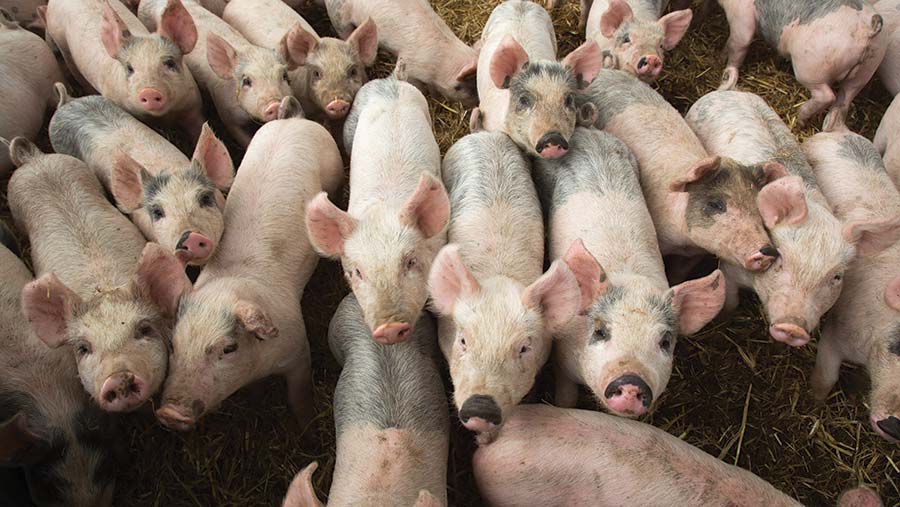Pig numbers to fall sharply in 2022 as costs and backlog bite
 © Tim Scrivener
© Tim Scrivener Significant financial losses by producers, backlogs of pigs and exceptionally high feed costs are expected to lead to a notable reduction in pig numbers.
Industry estimates forecast a 15% reduction in the UK pig herd by September this year, the British Pig & Poultry Fair Pig Outlook Forum heard.
Cost of production is estimated at 230p/kg for April, with losses of £58 a finished pig during the first quarter of 2022, according to AHDB.
Figures from processor Karro Food Group at the NAEC Stoneleigh event suggest the total backlog of pigs on farm is about 250,000 head, greatly outweighing Defra’s previous estimates.
See also: Pressure mounts on Tesco to pay more for pigmeat
Karro, which processes almost 30% of the UK pig kill and owns 26,000 sows, has killed an extra 80,000 pigs through its Malton abattoir in North Yorkshire since the backlog began.
Chief executive Steve Ellis said: “Pig prices move with supply and demand and are completely independent to cost of production.
“About 60% of pork consumed in the UK comes from Europe, and they are facing many of the same issues.”
Record high costs, soft retail demand
The root causes of the current crisis are record high costs of production, the backlog of about 70,000 pigs still on farm, and soft retail demand, according to Mr Ellis, who believes it will take about four weeks to clear the remaining surplus.
Data from Karro shows that the UK base kill each week is usually about 214,000 pigs, and it predicts that by August this will be down to 183,000 head a week.
A lack of boning capacity at Karro over the past year increased exports of bone-in cuts to markets such as Poland.
Mr Ellis said the firm was not planning on cutting back its own pig herd at all, and its numbers had remained stable for the past 18 months.
The forum heard that while most retailers had increased the price paid to producers, with Waitrose leading the way, more needed to be done.
The National Pig Association (NPA) most recently called on Tesco to do more and will be meeting the retailer in the next few weeks.
NPA chairman Rob Mutimer expects his own pig cost of production to be at 235p/kg by September, although he believes it could be even higher based on current feed prices.
Mr Mutimer said the industry had a critical lack of skilled labour and the government was not acknowledging the extent of the labour shortage.
“Independent producers have been hit harder than integrated businesses,” he said.
Contract reform
The NPA’s Rob Mutimer said there were monopolies in the pig sector both at retailer and processor level and that current producer contracts were often not up to scratch.
“Contracts in the pig sector all differ and are often not legally binding,” he said. “There are huge numbers of contracts which are still done on a handshake with multinational companies and that seems absolutely ludicrous.”
Outdated contracts were often not updated and rolled over year-on-year, Mr Mutimer said, and too many contracts were still based on the standard pig price.
Mr Mutimer and Karro’s Steve Ellis agreed that contracts based solely on costs of production would not be good for the industry, as businesses still needed to make a profit.
AHDB outlook
AHDB lead analyst Duncan Wyatt forecasts a material drop-off in production during the second half of 2022, which is expected to offer some support to pig prices as supply tightens.
Asia and the US were outlined as key export markets, with Asia offering high-volume, low-value exports, while the US market had potential for higher-value cuts.
Angela Christison, sector director of pork at the AHDB, said domestic consumers preferred pork legs and loins, with demand for 23m loins and 19m legs a year.
“Cuts such as belly, shoulder and heads have very little demand in the UK. However, they are worth more than £500m in overseas sales,” said Ms Christison.
